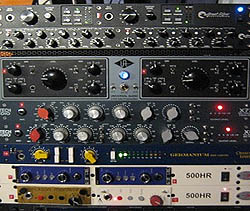As you may already know, I’m in the process of doing a few upgrades in my studio.
Whenever I’m looking to buy a new piece of equipment or upgrade an existing piece of equipment, I try to ask one simple question: What will help me make better recordings?
My goal isn’t to marginally improve the recordings. I’m looking for holes in my system. I’m looking for weak links.
For example, I don’t currently own an actual guitar amp (I’ve been using a pretty killer amp simulator pedal, but still don’t have an actual amp). A good amp would definitely improve my guitar recordings.
Also, I’m working on upgrading my cabling. It’s not a sexy upgrade, but it makes a noticeable difference. (More on that in a future article.)
Another deciding factor when I’m buying gear is whether or not the gear is “digital” or “analog.” Buying software, plug-ins, computers, is a lot of fun, and I have nothing against those things, but software inevitably has to be updated. Computers will eventually be too slow…or will simply die.
You know what lasts a lot longer and will work with ANY recording system? Good, analog equipment.
Examples of good analog equipment:
—microphones
—preamps/channel strips
—compressors
—EQs
—summing mixers
—acoustic treatment
—studio monitors, monitor controllers, headphones
—cables/stands
—guitar pedals/direct boxes
—guitars (and other instruments), amps
The following don’t qualify:
—audio interfaces
—AD/DA converters
—DAW software
—plugins/virtual instruments
—MIDI controllers
You’ll find that the list of analog gear can easily outnumber the list of digital gear. But aren’t we all guilty of drooling over the latest piece of software? The latest audio interface?
Again, there’s nothing wrong with these things, but I’ve put together a small list of reasons why you should (as much as it makes sense) invest in good, analog equipment.
1. Analog gear can last decades.
A lot of major studios around the world still use the same outboard gear they used thirty years ago. Sure, they might need to be repaired occasionally, or you might need to swap out tubes, etc.
But these studios have gone from analog tape to digital tape to full-on Pro Tools HD systems. All these systems can easily use the same analog equipment.
A good piece of analog hardware is timeless.
2. Analog gear is HOW you “get it right at the source.”
You hear it all over the place. When recording, you must “get it right at the source.” The idea of “fixing it in the mix” is absurd, if you aren’t diligent about first capturing the audio properly.
Analog gear will always be the only way to properly capture an analog source.
3. Analog gear never has compatibility issues.
Have you ever purchased a new computer, only to find you needed to upgrade a few pieces of software to get them to work? Yeah, me too.
I’ve never heard of somebody needing to upgrade his LA-610 when he updated his operating system, have you? Me neither. Analog gear will always be relevant and useful.
4. Analog gear (for the most part) maintains its value.
If at some point in the next 10 years you decide you want to sell your nice solid-state preamp for a high-end tube pre, you’ll get a lot more money for a good preamp than you will for a good audio interface. ESPECIALLY if the piece in question is over 5 years old.
Imagine buying a $1,000 interface and a $1,000 microphone today. In ten years, you could get a lot of money out of that microphone. You might not even be able to GIVE the audio interface away. It would probably be obsolete. A good mic is never obsolete.
Joe Gilder is a Nashville-based engineer, musician, and producer who also provides training and advice at the Home Studio Corner.Note that Joe also offers highly effective training courses, including Understanding Compression and Understanding EQ.





















